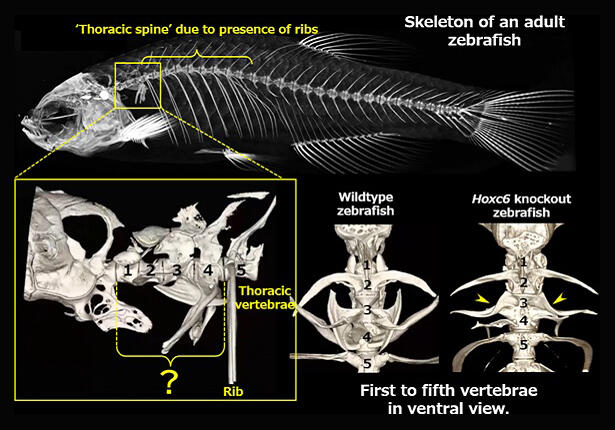Associate Professor Akinori Kawamura of the Graduate School of Science and Engineering at Saitama University, and Technical Specialist Akiteru Maeno of the National Institute of Genetics, in collaboration with Professor Masaru Matsuda and Associate Professor Norimasa Iwanami of the Center for Bioscience Research and Education at Utsunomiya University have shown that the second vertebra, which looks like a fish's neck bone, may actually be a thoracic vertebra, and only the most anterior vertebra in the fish may have properties similar to those of the cervical vertebrae. The findings suggest that vertebrates increased the number of cervical vertebrae and evolved complex neck structures in the process of water-to-land transition. The work was published in Development.

Provided by Saitama University
The backbone, common to all vertebrates, has a repeating structure consisting of a series of vertebrae. In humans, the vertebrae are classified, from the anterior side, as follows: cervical vertebrae, which are the neck bones; thoracic vertebrae, which connect to the ribs; and lumbar, sacral, and coccygeal vertebrae.
Fish have ribs and thoracic vertebrae, but do they have neck bones/cervical vertebrae? Morphological comparison is a typical method to compare different animals. However, large differences in the morphology of the anteriormost vertebrae between fish and mammals have precluded their morphological comparison, and the link has remained unclear. Studies in mice have shown that the Hox genes determine the characteristics of each vertebra. For example, Hoxc6 most accurately determines the most-head-side thoracic vertebra (shoulder position).
The zebrafish has thoracic vertebrae that connect to the ribs, which start from the fifth vertebra. Then, are the first through fourth vertebrae, which are more on the head side, cervical vertebrae? The research group produced Hoxc6 knockout zebrafish and found that the fish had abnormalities in the third and fourth vertebrae. This result suggests that the third and fourth vertebrae of the zebrafish were originally thoracic vertebrae and became morphologically unidentifiable as thoracic due to deformity of the ribs. The analysis of zebrafish and medaka, in which various Hox genes were broken, suggests that only the anterior vertebra may have properties similar to those of the cervical vertebrae.
In mice, several Hox genes have been shown to determine characteristics of the seven cervical vertebrae. However, their results suggest that zebrafish has the same Hox genes, but they may not be involved in determining the characteristics of their vertebrae. Based on the present findings, fish seem to have only one vertebra similar to the cervical vertebrae. Most mammals, including humans, have seven cervical vertebrae. Therefore, the results suggest that vertebrates increased the number of cervical vertebrae and developed neck structures with complex functions after the water-to-land transition.
Journal Information
Publication: Development
Title: The Hox code responsible for the patterning of the anterior vertebrae in zebrafish
DOI: 10.1242/dev.202854
This article has been translated by JST with permission from The Science News Ltd. (https://sci-news.co.jp/). Unauthorized reproduction of the article and photographs is prohibited.




